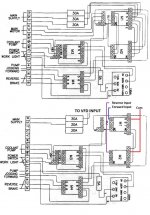I just picked up a nice used Acer 1440G lathe like this...
It will be used in my garage which provides only single phase power. I already have a Bridgeport mill in my garage, which is powered with a VFD that I wired up without any problems. My Bridgeport's VFD is wired so that it never experiences a zero load condition on its output which, from what I read, will quickly destroy a VFD. With the VFD output wired directly into the motor, this hasn't been a problem on my Bridgeport. Here is the bascis schematic I used on my Bridgeport:
single phase 220VAC from breaker box----> E-stop switch--->input to VFD----->VFD outputs 3 phase 220VAC---->Bridgeport 1-1/2hp motor.
But now I have this new machine and it has an integrated on/off switch built into the carriage/apron/saddle and also an integrated e-stop button. So offhand, I don't see how I can easily connect a VFD to the machine's power input without risking a zero load condition. Any ideas on how to approach this problem so that the lathe can be fully used the way it is intended?
It will be used in my garage which provides only single phase power. I already have a Bridgeport mill in my garage, which is powered with a VFD that I wired up without any problems. My Bridgeport's VFD is wired so that it never experiences a zero load condition on its output which, from what I read, will quickly destroy a VFD. With the VFD output wired directly into the motor, this hasn't been a problem on my Bridgeport. Here is the bascis schematic I used on my Bridgeport:
single phase 220VAC from breaker box----> E-stop switch--->input to VFD----->VFD outputs 3 phase 220VAC---->Bridgeport 1-1/2hp motor.
But now I have this new machine and it has an integrated on/off switch built into the carriage/apron/saddle and also an integrated e-stop button. So offhand, I don't see how I can easily connect a VFD to the machine's power input without risking a zero load condition. Any ideas on how to approach this problem so that the lathe can be fully used the way it is intended?





